ECU Lancia Thema 2013 Owner handbook (in English)
[x] Cancel search | Manufacturer: LANCIA, Model Year: 2013, Model line: Thema, Model: Lancia Thema 2013Pages: 336, PDF Size: 3.87 MB
Page 15 of 336

2
THINGS TO KNOW BEFORE STARTING
YOUR VEHICLE
A WORD ABOUT YOUR KEYS . . . . . . . . . . . . . . . .12 KEYLESS IGNITION NODE (KIN) . . . . . . . . . . .12
KEY FOB . . . . . . . . . . . . . . . . . . . . . . . . . . . . . .12
IGNITION OR ACCESSORY ON MESSAGE . . . . .13
SENTRY KEY® . . . . . . . . . . . . . . . . . . . . . . . . . . .13
REPLACEMENT KEYS . . . . . . . . . . . . . . . . . . .14
CUSTOMER KEY PROGRAMMING . . . . . . . . . .14
GENERAL INFORMATION . . . . . . . . . . . . . . . . .14
VEHICLE SECURITY ALARM . . . . . . . . . . . . . . . .15
REARMING OF THE SYSTEM . . . . . . . . . . . . . .15
TO ARM THE SYSTEM . . . . . . . . . . . . . . . . . . . .15
TO DISARM THE SYSTEM . . . . . . . . . . . . . . . . .15
PREMIUM SECURITY SYSTEM (for versions/markets, where provided) . . . . . . . . .16
TO ARM THE SYSTEM . . . . . . . . . . . . . . . . . . . .16
TO DISARM THE SYSTEM . . . . . . . . . . . . . . . . .17
SECURITY SYSTEM MANUAL OVERRIDE. . . . .17
ILLUMINATED ENTRY (for versions/markets, where provided) . . . . . . . . .17
9
Page 19 of 336

IGNITION OR ACCESSORY
ON MESSAGE
Opening the driver's door when the
ignition is in ACC or ON (engine not
running), a chime will sound to re-
mind you to cycle the ignition to OFF.
In addition to the chime, the ignition
or accessory on message will display
in the cluster.
NOTE:
With the Uconnect Touch™
system, the power window switches,
radio, power sunroof (for versions/
markets, where provided), and
power outlets will remain active for
up to 10 minutes after the ignition is
cycled to the OFF position. Opening
either front door will cancel this fea-
ture. The time for this feature is pro-
grammable. Refer to “Uconnect
Touch™ Settings” in “Understand-
ing Your Instrument Panel” for fur-
ther information.
WARNING!
When leaving the vehicle, always remove the Key Fob from the
vehicle and lock your vehicle.
Never leave children alone in a vehicle, or with access to an un-
locked vehicle.
Allowing children to be in a ve- hicle unattended is dangerous
for a number of reasons. A child
or others could be seriously or
fatally injured. Children should
be warned not to touch the park-
ing brake, brake pedal or the shift
lever.
Do not leave the Key Fob in or near the vehicle, or in a location
accessible to children, and do not
leave Keyless EnterNGo™ in
the ACC or ON/RUN mode. A
child could operate power win-
dows, other controls, or move the
vehicle.
Do not leave children or animals
inside parked vehicles in hot
weather. Interior heat build-up
may cause serious injury or death.
CAUTION!
An unlocked car is an invitation to
thieves. Always remove the Key
Fob from vehicle, cycle the ignition
OFF and lock all doors when leav-
ing the vehicle unattended.
SENTRY KEY®
The Sentry Key® Immobilizer System
prevents unauthorized vehicle oper-
ation by disabling the engine. The
system does not need to be armed or
activated. Operation is automatic,
regardless of whether the vehicle is
locked or unlocked.
The system uses a Key Fob with
Remote Keyless Entry (RKE) trans-
mitter, a Keyless Ignition Node (KIN)
and a RF receiver to prevent unau-
thorized vehicle operation. Therefore,
only Key Fobs that are programmed
to the vehicle can be used to start and
operate the vehicle.After placing the ignition in the ON/
RUN position, the Vehicle Security
13
Page 20 of 336
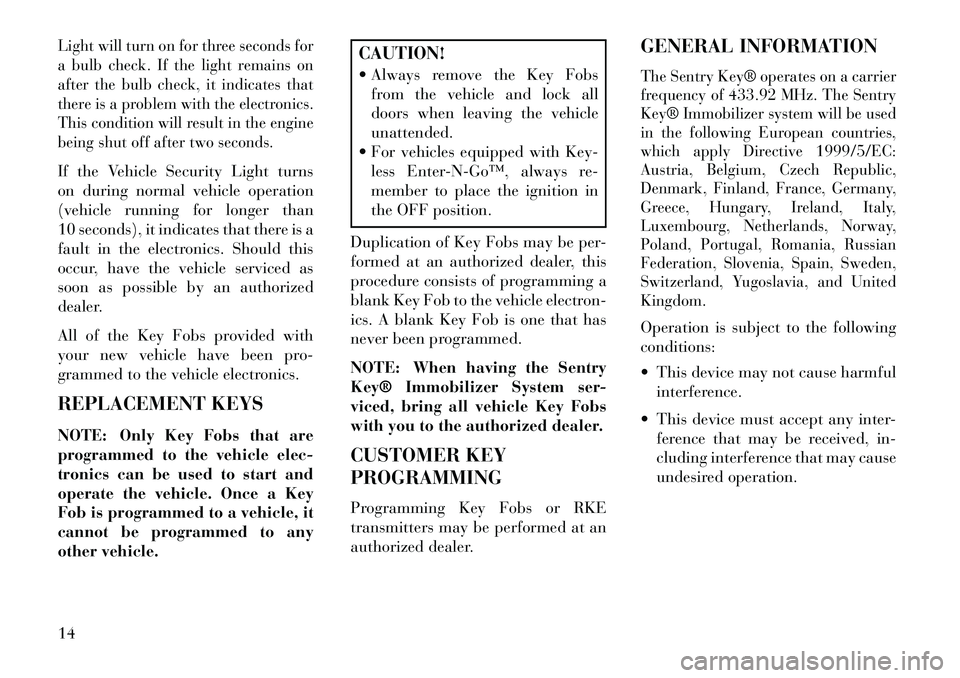
Light will turn on for three seconds for
a bulb check. If the light remains on
after the bulb check, it indicates that
there is a problem with the electronics.
This condition will result in the engine
being shut off after two seconds.If the Vehicle Security Light turns
on during normal vehicle operation
(vehicle running for longer than
10 seconds), it indicates that there is a
fault in the electronics. Should this
occur, have the vehicle serviced as
soon as possible by an authorized
dealer.
All of the Key Fobs provided with
your new vehicle have been pro-
grammed to the vehicle electronics.
REPLACEMENT KEYS
NOTE: Only Key Fobs that are
programmed to the vehicle elec-
tronics can be used to start and
operate the vehicle. Once a Key
Fob is programmed to a vehicle, it
cannot be programmed to any
other vehicle.
CAUTION!
Always remove the Key Fobsfrom the vehicle and lock all
doors when leaving the vehicle
unattended.
For vehicles equipped with Key- less EnterNGo™, always re-
member to place the ignition in
the OFF position.
Duplication of Key Fobs may be per-
formed at an authorized dealer, this
procedure consists of programming a
blank Key Fob to the vehicle electron-
ics. A blank Key Fob is one that has
never been programmed.
NOTE: When having the Sentry
Key® Immobilizer System ser-
viced, bring all vehicle Key Fobs
with you to the authorized dealer.
CUSTOMER KEY
PROGRAMMING
Programming Key Fobs or RKE
transmitters may be performed at an
authorized dealer. GENERAL INFORMATION
The Sentry Key® operates on a carrier
frequency of 433.92 MHz. The Sentry
Key® Immobilizer system will be used
in the following European countries,
which apply Directive 1999/5/EC:
Austria, Belgium, Czech Republic,
Denmark, Finland, France, Germany,
Greece, Hungary, Ireland, Italy,
Luxembourg, Netherlands, Norway,
Poland, Portugal, Romania, Russian
Federation, Slovenia, Spain, Sweden,
Switzerland, Yugoslavia, and United
Kingdom.Operation is subject to the following
conditions:
This device may not cause harmful
interference.
This device must accept any inter- ference that may be received, in-
cluding interference that may cause
undesired operation.
14
Page 21 of 336
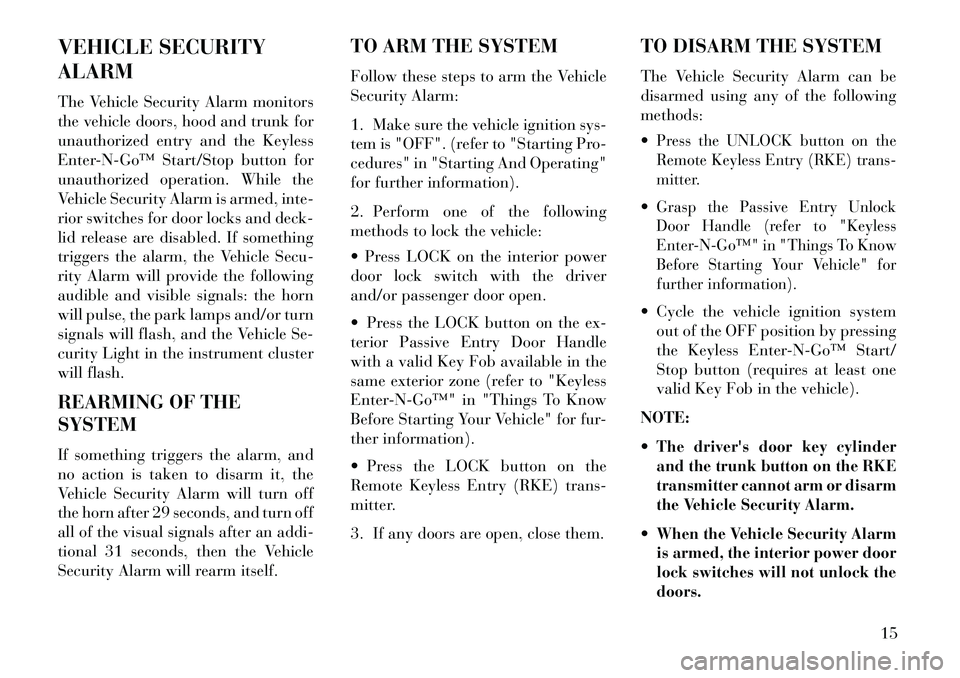
VEHICLE SECURITY
ALARM
The Vehicle Security Alarm monitors
the vehicle doors, hood and trunk for
unauthorized entry and the Keyless
EnterNGo™ Start/Stop button for
unauthorized operation. While the
Vehicle Security Alarm is armed, inte-
rior switches for door locks and deck-
lid release are disabled. If something
triggers the alarm, the Vehicle Secu-
rity Alarm will provide the following
audible and visible signals: the horn
will pulse, the park lamps and/or turn
signals will flash, and the Vehicle Se-
curity Light in the instrument cluster
will flash.
REARMING OF THE
SYSTEM
If something triggers the alarm, and
no action is taken to disarm it, the
Vehicle Security Alarm will turn off
the horn after 29 seconds, and turn off
all of the visual signals after an addi-
tional 31 seconds, then the Vehicle
Security Alarm will rearm itself.TO ARM THE SYSTEM
Follow these steps to arm the Vehicle
Security Alarm:
1. Make sure the vehicle ignition sys-
tem is "OFF". (refer to "Starting Pro-
cedures" in "Starting And Operating"
for further information).
2. Perform one of the following
methods to lock the vehicle:
Press LOCK on the interior power
door lock switch with the driver
and/or passenger door open.
Press the LOCK button on the ex-
terior Passive Entry Door Handle
with a valid Key Fob available in the
same exterior zone (refer to "Keyless
EnterNGo™" in "Things To Know
Before Starting Your Vehicle" for fur-
ther information).
Press the LOCK button on the
Remote Keyless Entry (RKE) trans-
mitter.
3. If any doors are open, close them.
TO DISARM THE SYSTEM
The Vehicle Security Alarm can be
disarmed using any of the following
methods:
Press the UNLOCK button on the
Remote Keyless Entry (RKE) trans-
mitter.Grasp the Passive Entry Unlock
Door Handle (refer to "Keyless
EnterNGo™" in "Things To Know
Before Starting Your Vehicle" for
further information). Cycle the vehicle ignition system
out of the OFF position by pressing
the Keyless EnterNGo™ Start/
Stop button (requires at least one
valid Key Fob in the vehicle).
NOTE:
The driver's door key cylinder
and the trunk button on the RKE
transmitter cannot arm or disarm
the Vehicle Security Alarm.When the Vehicle Security Alarm
is armed, the interior power door
lock switches will not unlock the
doors.
15
Page 22 of 336
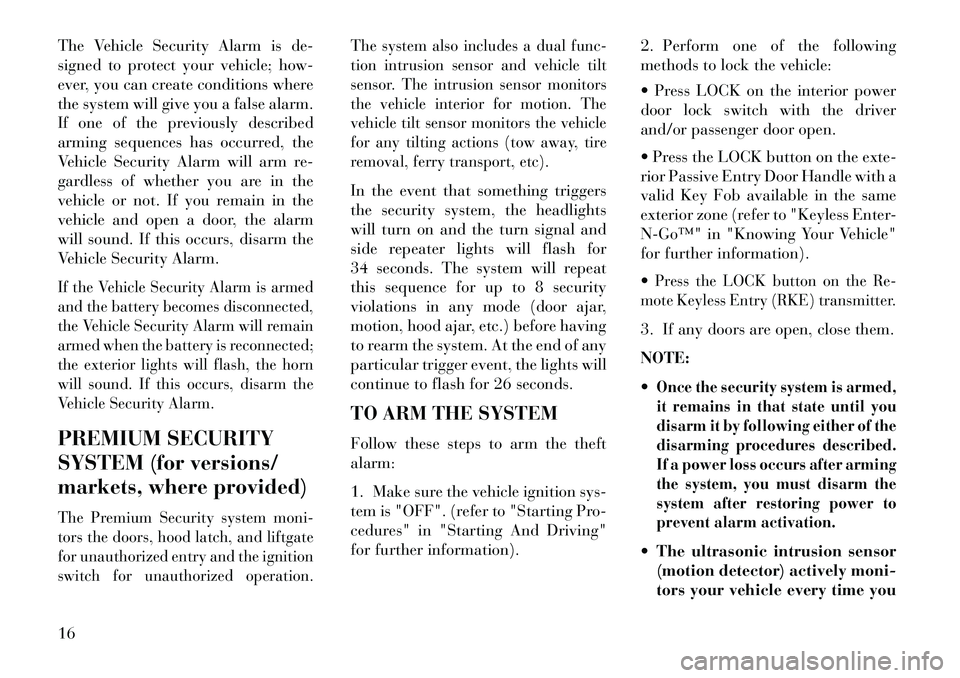
The Vehicle Security Alarm is de-
signed to protect your vehicle; how-
ever, you can create conditions where
the system will give you a false alarm.
If one of the previously described
arming sequences has occurred, the
Vehicle Security Alarm will arm re-
gardless of whether you are in the
vehicle or not. If you remain in the
vehicle and open a door, the alarm
will sound. If this occurs, disarm the
Vehicle Security Alarm.If the Vehicle Security Alarm is armed
and the battery becomes disconnected,
the Vehicle Security Alarm will remain
armed when the battery is reconnected;
the exterior lights will flash, the horn
will sound. If this occurs, disarm the
Vehicle Security Alarm.PREMIUM SECURITY
SYSTEM (for versions/
markets, where provided)The Premium Security system moni-
tors the doors, hood latch, and liftgate
for unauthorized entry and the ignition
switch for unauthorized operation.The system also includes a dual func-
tion intrusion sensor and vehicle tilt
sensor. The intrusion sensor monitors
the vehicle interior for motion. The
vehicle tilt sensor monitors the vehicle
for any tilting actions (tow away, tire
removal, ferry transport, etc).
In the event that something triggers
the security system, the headlights
will turn on and the turn signal and
side repeater lights will flash for
34 seconds. The system will repeat
this sequence for up to 8 security
violations in any mode (door ajar,
motion, hood ajar, etc.) before having
to rearm the system. At the end of any
particular trigger event, the lights will
continue to flash for 26 seconds.
TO ARM THE SYSTEM
Follow these steps to arm the theft
alarm:
1. Make sure the vehicle ignition sys-
tem is "OFF". (refer to "Starting Pro-
cedures" in "Starting And Driving"
for further information).
2. Perform one of the following
methods to lock the vehicle:
Press LOCK on the interior power
door lock switch with the driver
and/or passenger door open.
Press the LOCK button on the exte-
rior Passive Entry Door Handle with a
valid Key Fob available in the same
exterior zone (refer to "Keyless Enter-
NGo™" in "Knowing Your Vehicle"
for further information).
Press the LOCK button on the Re-
mote Keyless Entry (RKE) transmitter.3. If any doors are open, close them.
NOTE:
Once the security system is armed,
it remains in that state until you
disarm it by following either of the
disarming procedures described.
If a power loss occurs after arming
the system, you must disarm the
system after restoring power to
prevent alarm activation. The ultrasonic intrusion sensor (motion detector) actively moni-
tors your vehicle every time you
16
Page 23 of 336

arm the security system. If you
prefer, you can turn OFF the
ultrasonic intrusion sensor and
vehicle tilt sensor when arming
the security system. To do so,
press the LOCK button on the
RKE transmitter three times
within 5 seconds of arming the
system (while the Vehicle Secu-
rity Light is flashing rapidly).
TO DISARM THE SYSTEM
The Vehicle Security Alarm can be
disarmed using any of the following
methods:
Press the UNLOCK button on the
Remote Keyless Entry (RKE) trans-
mitter. Grasp the Passive Entry Unlock Door Handle with a valid key fob
available in the same exterior zone
(refer to "Keyless EnterNGo™"
in "Knowing Your Vehicle" for fur-
ther information). Cycle the vehicle ignition system
out of the OFF position by pressing
the Keyless EnterNGo™ Start/
Stop button (requires at least one
valid Key Fob in the vehicle).
NOTE:
The driver's door key cylinder
and the liftgate button on the RKE
transmitter cannot arm or disarm
the Vehicle Security Alarm.When the Vehicle Security Alarm
is armed, the interior power door
lock switches will not unlock the
doors.The Vehicle Security Alarm is de-
signed to protect your vehicle; how-
ever, you can create conditions where
the system will give you a false alarm.
If one of the previously described
arming sequences has occurred, the
Vehicle Security Alarm will arm re-
gardless of whether you are in the
vehicle or not. If you remain in the
vehicle and open a door, the alarm
will sound. If this occurs, disarm the
Vehicle Security Alarm.
If the Vehicle Security Alarm is armed
and the battery becomes disconnected,
the Vehicle Security Alarm will remain
armed when the battery is recon-
nected; the exterior lights will flash,
the horn will sound. If this occurs,
disarm the Vehicle Security Alarm.SECURITY SYSTEM
MANUAL OVERRIDE
The system will not arm if you lock
the doors using the manual door lock
plunger.
ILLUMINATED ENTRY
(for versions/markets,
where provided)
The courtesy lights will turn on when
you use the Remote Keyless Entry
(RKE) transmitter to unlock the
doors or open any door.This feature also turns on the approach
lighting in the outside mirrors (for
versions/markets, where provided).
Refer to “Mirrors” in “Understanding
The Features Of Your Vehicle” for fur-
ther information.
17
Page 26 of 336
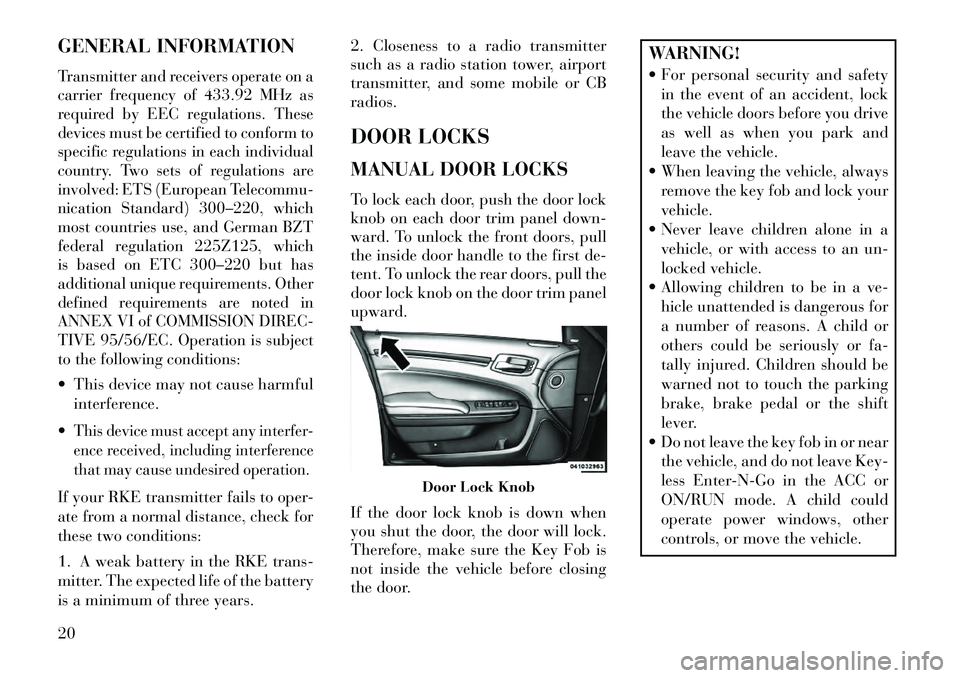
GENERAL INFORMATIONTransmitter and receivers operate on a
carrier frequency of 433.92 MHz as
required by EEC regulations. These
devices must be certified to conform to
specific regulations in each individual
country. Two sets of regulations are
involved: ETS (European Telecommu-
nication Standard) 300–220, which
most countries use, and German BZT
federal regulation 225Z125, which
is based on ETC 300–220 but has
additional unique requirements. Other
defined requirements are noted in
ANNEX VI of COMMISSION DIREC-
TIVE 95/56/EC. Operation is subject
to the following conditions: This device may not cause harmfulinterference.
This device must accept any interfer-
ence received, including interference
that may cause undesired operation.If your RKE transmitter fails to oper-
ate from a normal distance, check for
these two conditions:
1. A weak battery in the RKE trans-
mitter. The expected life of the battery
is a minimum of three years. 2. Closeness to a radio transmitter
such as a radio station tower, airport
transmitter, and some mobile or CB
radios.
DOOR LOCKS
MANUAL DOOR LOCKS
To lock each door, push the door lock
knob on each door trim panel down-
ward. To unlock the front doors, pull
the inside door handle to the first de-
tent. To unlock the rear doors, pull the
door lock knob on the door trim panel
upward.
If the door lock knob is down when
you shut the door, the door will lock.
Therefore, make sure the Key Fob is
not inside the vehicle before closing
the door.
WARNING!
For personal security and safety
in the event of an accident, lock
the vehicle doors before you drive
as well as when you park and
leave the vehicle.
When leaving the vehicle, always
remove the key fob and lock your
vehicle.
Never leave children alone in a vehicle, or with access to an un-
locked vehicle.
Allowing children to be in a ve- hicle unattended is dangerous for
a number of reasons. A child or
others could be seriously or fa-
tally injured. Children should be
warned not to touch the parking
brake, brake pedal or the shift
lever.
Do not leave the key fob in or near the vehicle, and do not leave Key-
less Enter-N-Go in the ACC or
ON/RUN mode. A child could
operate power windows, other
controls, or move the vehicle.
Door Lock Knob
20
Page 33 of 336
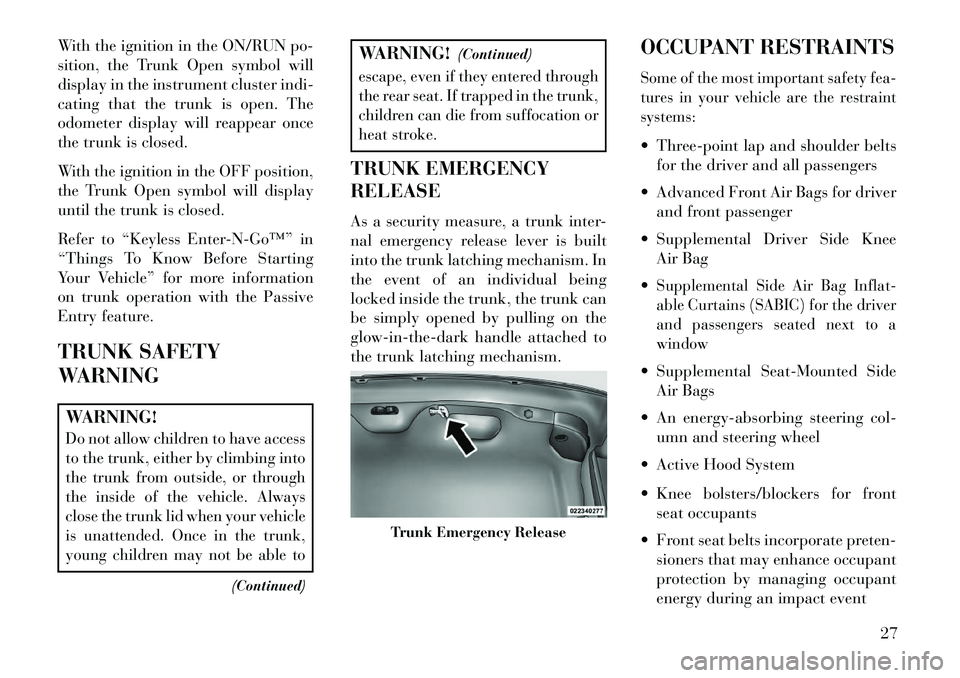
With the ignition in the ON/RUN po-
sition, the Trunk Open symbol will
display in the instrument cluster indi-
cating that the trunk is open. The
odometer display will reappear once
the trunk is closed.
With the ignition in the OFF position,
the Trunk Open symbol will display
until the trunk is closed.
Refer to “Keyless EnterNGo™” in
“Things To Know Before Starting
Your Vehicle” for more information
on trunk operation with the Passive
Entry feature.
TRUNK SAFETY
WARNINGWARNING!Do not allow children to have access
to the trunk, either by climbing into
the trunk from outside, or through
the inside of the vehicle. Always
close the trunk lid when your vehicle
is unattended. Once in the trunk,
young children may not be able to
(Continued)
WARNING!(Continued)escape, even if they entered through
the rear seat. If trapped in the trunk,
children can die from suffocation or
heat stroke.TRUNK EMERGENCY
RELEASE
As a security measure, a trunk inter-
nal emergency release lever is built
into the trunk latching mechanism. In
the event of an individual being
locked inside the trunk, the trunk can
be simply opened by pulling on the
glow-in-the-dark handle attached to
the trunk latching mechanism. OCCUPANT RESTRAINTS
Some of the most important safety fea-
tures in your vehicle are the restraint
systems: Three-point lap and shoulder belts
for the driver and all passengers
Advanced Front Air Bags for driver and front passenger
Supplemental Driver Side Knee Air Bag
Supplemental Side Air Bag Inflat-
able Curtains (SABIC) for the driver
and passengers seated next to a
window Supplemental Seat-Mounted Side Air Bags
An energy-absorbing steering col- umn and steering wheel
Active Hood System
Knee bolsters/blockers for front seat occupants
Front seat belts incorporate preten- sioners that may enhance occupant
protection by managing occupant
energy during an impact event
Trunk Emergency Release
27
Page 34 of 336

All seat belt systems (except the
driver’s and front passenger's) in-
clude Automatic Locking Retractors
(ALRs), which lock the seat belt
webbing into position by extending
the belt all the way out and then
adjusting the belt to the desired
length to restrain a child seat or
secure a large item in a seatPlease pay close attention to the infor-
mation in this section. It tells you how
to use your restraint system properly,
to keep you and your passengers as
safe as possible.
If you will be carrying children too
small for adult-sized seat belts, the
seat belts or the ISOFIX feature also
can be used to hold infant and child
restraint systems. For more informa-
tion, refer to ISOFIX — Child Seat
Anchorage System.
NOTE: The Advanced Front Air
Bags have a multistage inflator
design. This allows the air bag to
have different rates of inflation
based on several factors, including
the severity and type of collision.Here are some simple steps you can
take to minimize the risk of harm
from a deploying air bag:
1.
Children 12 years old and un-
der should always ride buckled up
in a rear seat.
WARNING!
Infants in rear facing child re-
straints should never ride in the
front seat of a vehicle with a pas-
senger Advanced Front Air Bag.
An air bag deployment can cause
severe injury or death to infants in
that position.
Children that are not big enough to
wear the vehicle seat belt properly
(see section on Child Restraints)
should be secured in the rear seat in
child restraints or belt-positioning
booster seats. Older children who do
not use child restraints or belt-
positioning booster seats should ride
properly buckled up in the rear seat.
Never allow children to slide the
shoulder belt behind them or under
their arm.
You should read the instructions pro-
vided with your child restraint to make
sure that you are using it properly.2. All occupants should always
wear their lap and shoulder belts
properly.
3. The driver and front passenger
seats should be moved back as far
as practical to allow the Advanced
Front Air Bags room to inflate.
4. Do not lean against the door or
window. If your vehicle has side
air bags, and deployment occurs,
the side air bags will inflate force-
fully into the space between you
and the door.
5. If the air bag system in this
vehicle needs to be modified to
accommodate a disabled person,
contact the Customer Center.WARNING!
Infants in rear facing child re-
straints should never ride in the
front seat of a vehicle with a pas-
senger Advanced Front Air Bag.
(Continued)
28
Page 38 of 336

SEAT BELTS IN
PASSENGER SEATING
POSITIONSThe seat belts in the rear passenger
seating positions are equipped with
Automatic Locking Retractors (ALR)
which are used to secure a child re-
straint system. For additional infor-
mation, refer to “Installing Child
Restraints Using The Vehicle Seat
Belt” under the “Child Restraints” sec-
tion. The chart below defines the type
of feature for each seating position.
Driver Center Passen-ger
First
Row N/A N/A N/A
Second
Row ALR ALR ALR
N/A — Not ApplicableALR — Automatic Locking Retractor
If the passenger seating position is
equipped with an ALR and is being
used for normal usage:
Only pull the belt webbing out far
enough to comfortably wrap around
the occupant's mid-section so as to
not activate the ALR. If the ALR is
activated, you will hear a ratcheting
sound as the belt retracts. Allow the
webbing to retract completely in this
case and then carefully pull out only
the amount of webbing necessary to
comfortably wrap around the occu-
pant's mid-section. Slide the latch
plate into the buckle until you hear a
"click."
AUTOMATIC LOCKING
RETRACTOR MODE (ALR)
In this mode, the shoulder belt is
automatically pre-locked. The belt
will still retract to remove any slack in
the shoulder belt. The Automatic
Locking Mode is available on all rear
passenger-seating positions with a
combination lap/shoulder belt. Use
the Automatic Locking Mode anytime a child safety seat is installed in a
seating position that has a belt with
this feature. Children 12 years old
and under should always be properly
restrained in the rear seat.
How To Engage The Automatic
Locking Mode
1. Buckle the combination lap and
shoulder belt.
2. Grasp the shoulder portion and
pull downward until the entire belt is
extracted.
3. Allow the belt to retract. As the
belt retracts, you will hear a clicking
sound. This indicates the safety belt is
now in the Automatic Locking Mode.
How To Disengage The Automatic
Locking Mode
Unbuckle the combination lap/
shoulder belt and allow it to retract
completely to disengage the Auto-
matic Locking Mode and activate the
vehicle sensitive (emergency) locking
mode.
32